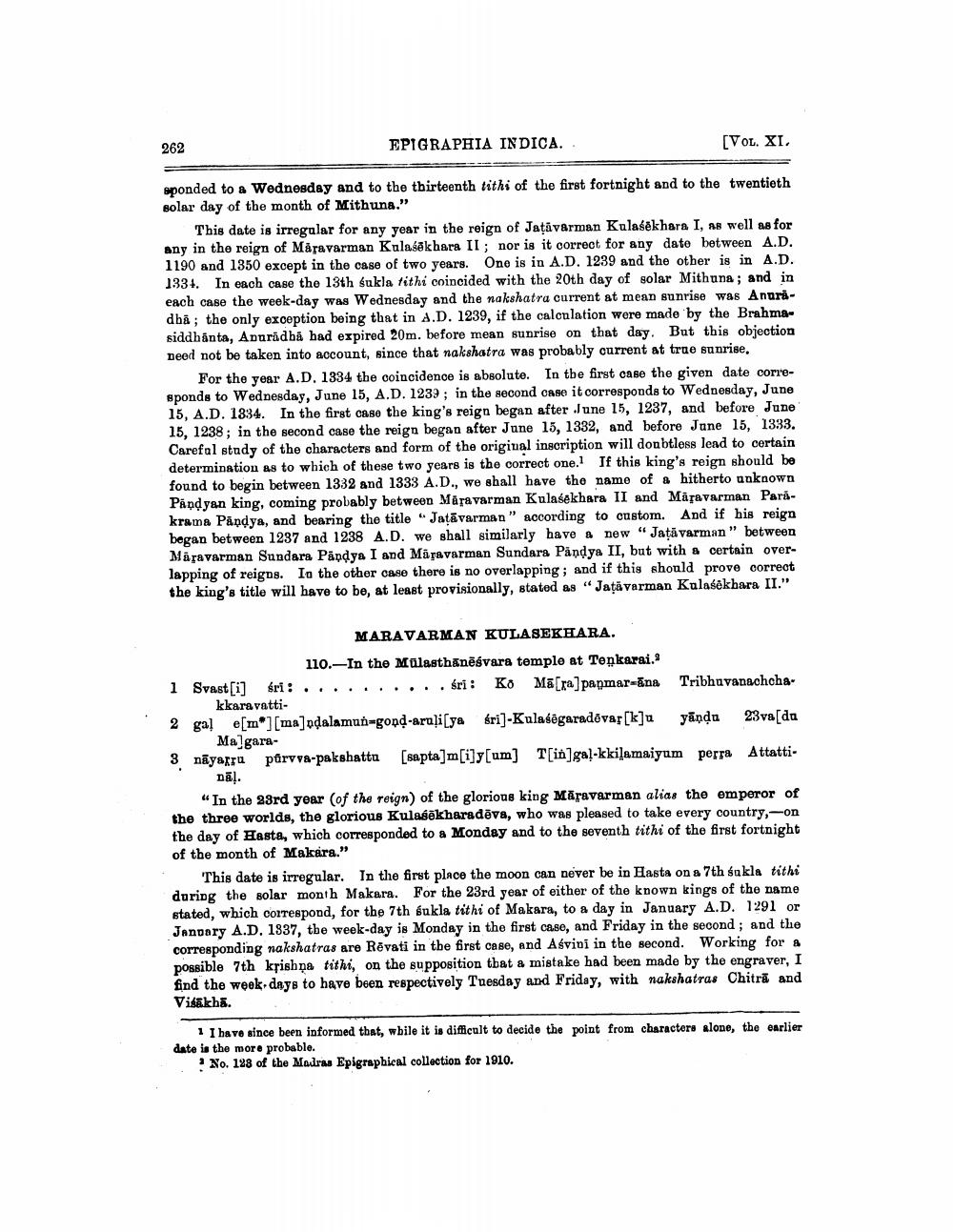________________
EPIGRAPHIA INDICA.,
(VOL. XI.
sponded to a Wednesday and to the thirteenth tithi of the first fortnight and to the twentieth solar day of the month of Mithuna."
This date is irregular for any year in the reign of Jațăvarman Kulasekhara I, as well as for any in the reign of Måravarman Kulasekhara II ; nor is it correct for any date between A.D. 1190 and 1350 except in the case of two years. One is in A.D. 1239 and the other is in A.D. 133t. In each case the 13th sukla tithi coincided with the 20th day of solar Mithuna; and in each case the week-day was Wednesday and the nakshatra current at mean sunrise was Antridha; the only exception being that in A.D. 1239, if the calcnlation were made by the Brahmasiddhanta, Anuradha bad expired 20m. before mean sunrise on that day. But this objection Deed not be taken into account, since that nakshatra was probably current at true sunrise.
For the year A.D. 1334 the coincidence is absolute. In tbe first case the given date corresponds to Wednesday, June 15, A.D. 1239; in the second case it corresponds to Wednesday, June 15, A.D. 1834. In the first case the king's reign began after June 15, 1237, and before June 15, 1238; in the second case the reign began after June 15, 1332, and before Jane 15, 1333. Carefal study of the characters and form of the original inscription will donbtless lead to certain determination as to which of these two years is the correct one. If this king's reign should be found to begin between 1332 and 1333 A.D., we shall have the name of a hitherto unknown Pandyan king, coming probably between Märavarman Kulasekhara II and Mäsavarman Parăkrama Pandya, and bearing the title " Jațāvarman" according to custom. And if his reign began between 1237 and 1238 A.D. we shall similarly have a new "Jațăvarman" between Māsavarman Sundara Pandya I and Māravarman Sundara Pandya II, but with a certain overlapping of reigns. In the other case there is no overlapping; and if this should prove correct the king's title will have to be, at least provisionally, stated as “Jaţăvarman Kulasekhara II."
MARAVARMAN KULASEKHARA.
110.-In the Malasthanēśvara templo at Tenkarai. 1 Svast[i] eri: .......... sri: Ko Mā[ra]panmar=āna Tribhuvanachcha
kkaravatti2 gale[m] [ma]odalaman=gond-aruļi(ya sri]-Kulasegaradēvar[k]
u yāṇda 23 va[da Malgara3 nāyafru parvva-pakshatta [sapta]m[i]y[um] T[in]gal-kkilamaiyum perra Attatti
Dā!
"In the 23rd year of the reign) of the glorious king Māravarman alias the emperor of the three worlds, the glorious Kulasēkharadēva, who was pleased to take every country-on the day of Hasta, which corresponded to a Monday and to the seventh tithi of the first fortnight of the month of Makara."
This date is irregular. In the first place the moon can never be in Hasta on a 7th sukla tithi during the solar month Makara. For the 23rd year of either of the known kings of the name stated, which correspond, for the 7th bukla tithi of Makara, to a day in January A.D. 1291 or Jandary A.D. 1937, the week-day is Monday in the first case, and Friday in the second ; and the corresponding nakshatras are Rēvati in the first case, and Aśvivi in the second. Working for a possible 7th ksishņa tithi, on the supposition that a mistake had been made by the engraver, I find the week. days to have been respectively Tuesday and Friday, with nakshatras Chitrā and Visakh.
characters alone, the earlier
1 I have since been informed that, while it is difficult to decide the point from date is the more probable.
No. 128 of the Malras Epigraphical collection for 1910.




